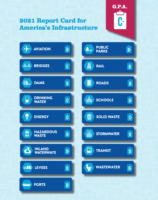Infrastructure Investment Opportunities Evolve as Federal Funding Lags

California high-speed rail project was a topic at the Infraday West symposium.
PHOTO BY JOHN LIVSEY FOR ENR
As uncertainty drags on concerning federal funding levels for major infrastructure projects, stakeholders are looking more intensely than ever into what kinds of private capital are available—not only from entities traditionally interested in infrastructure, but also from companies such as Facebook.
From a finance point of view, “infrastructure is becoming distinct from other types of investments,” said Allan Marks, a partner at Milbank, Tweed, Hadley & McCloy, a firm that handles major business transactions. But in the U.S., regarding public-private partnerships so far, the sense is that “we like to make mistakes and not learn from them,” he told attendees of Infraday West, a one-day symposium held Dec. 5 in Los Angeles.
Panelists discussing the state of the western U.S. infrastructure market agreed that the federal government is a less reliable partner these days. “The administration promised a $1-trillion bill, but we haven’t seen fruition,” said Todd McIntyre, chief of staff for the District of Columbia’s Dept. of Transportation. DDOT has $1 billion in capital improvement projects coming, “but there is skittishness from the private side,” he added, holding out hopes for a bipartisan bill after the midterm elections.
Lawrence Pierce, San Diego representative for the American Society of Civil Engineers, said there is a $2-trillion investment need for infrastructure over the next decade. “We have to have all the players playing,” he said.
Cherian George, head of infrastructure for the Americas with Fitch Ratings, said infrastructure goals are better met by a long-term approach. “If we had all the money now, it would drive prices up,” he said. “We need time to ramp up.”
He added that Fitch’s 2019 credit outlook for transportation was positive, mostly tracking national GDP. But beyond that, “there are concerns, fear of dark clouds. We may be close to the end of a good period.”
Colin Peppard, senior director with the Office of Extraordinary Innovation at Los Angeles Metro, noted some positives regarding the feds. For example, the Federal Transit Administration has an expedited pilot program for New Starts transit projects, where increased private investment and lower federal contributions could lead to fewer restrictions and regulations. He also noted that his agency received a $1.2-million grant to pursue a performance-based mobility-as-a-service contract.
Making the Case
Dan Richards, chair of the California High Speed Rail Authority, made a business case to investors in the room regarding the controversial $77-billion plan to build a high-speed network traversing California.
He noted that other existing high-speed rail systems generate positive cash flows. He said that the Central Valley, where $3 billion in high-speed rail work is underway, would be the 24th-largest state and the poorest. That, coupled with frothy Silicon Valley housing prices, could be addressed if the young workforce could live in the Central Valley and commute via high-speed rail. Connections to a planned Google campus would be only 42 minutes from Madera and 50 minutes from Fresno, he said.
Another example of how big tech can contribute to infrastructure is the Dumbarton Transportation Corridor. Winsome Bowen, head of regional transportation strategy with Facebook, says the company negotiated with the public agency that owns the moribund East Bay crossing. The tech firm wants to conduct its own feasibility study regarding the possibility of redeveloping the route.
“You give us the right of way, and we will design-build, operate and maintain it for 35 to 50 years,” added Sia Kusha, project development and partnering group leader with the Plenary Group.
Bowen said that the company selected feasibility consultants within four months—as opposed to the 18 to 24 months the public agency would require—while being transparent and inclusive of the public. “Facebook is not averse to taking risks,” she said. “We’d rather spend the money ourselves to see if it is feasible.”


